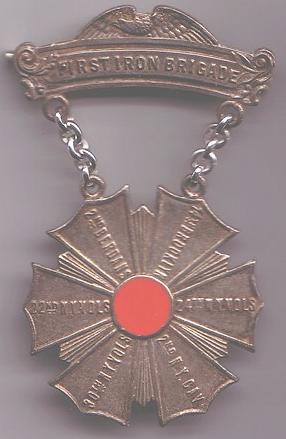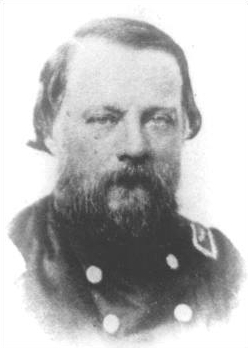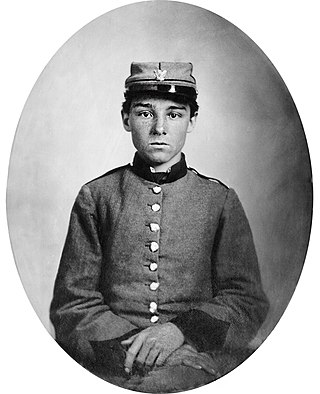The Irish Brigade was an infantry brigade, consisting predominantly of Irish Americans, who served in the Union Army in the American Civil War. The designation of the first regiment in the brigade, the 69th New York Infantry, or the "Fighting 69th," continued in later wars. The Irish Brigade was known in part for its famous war cry, the "Faugh a Ballaugh" which is an anglicization of the Irish phrase, fág an bealach, meaning "clear the way" and used in various Irish-majority military units founded due to the Irish diaspora. According to Fox's Regimental Losses, of all Union army brigades, only the 1st Vermont Brigade and Iron Brigade suffered more combat dead than the Irish Brigade during America's Civil War.

Samuel Kosciuszko Zook was a Union general during the American Civil War who was mortally wounded in action at the Battle of Gettysburg.
The 14th Indiana Infantry Regiment, called "The Gallant Fourteenth," was an infantry regiment and part of the Union Army's celebrated "Gibraltar Brigade" during the American Civil War. Mustered on June 7, 1861, it was the state's first regiment organized for three years' service. The 14th Indiana served in many major campaigns and battles mostly in the Eastern Theater. During its three years of service, the regiment had a total of 222 casualties.

The 90th Regiment, Pennsylvania Volunteer Infantry was a volunteer infantry regiment which served in the Union Army during the American Civil War. They wore chasseur-style uniforms, which each consisted of a dark blue habit veste with white trim, baggy sky-blue trousers and a dark blue kepi. The buttons on the habit veste were unique to the 90th Pennsylvania. They were the only Union regiment in the entire war to have a specific button design.

The Eastern Iron Brigade, also known as the Iron Brigade of the East and First Iron Brigade, was a brigade of infantry, that served in the Union Army's Army of the Potomac, during the American Civil War. For much of its service, it was designated as the 1st Brigade, 1st Division, I Corps. Among its commanding officers were General John P. Hatch and General Walter Phelps Jr. Noted for its reliability in battle, the brigade developed a reputation which remained after it was disbanded late in the war, due to its annihilation from extremely high casualties.

Ezra Ayers Carman was an officer in the Union Army during the American Civil War, commanding a New Jersey infantry regiment and (occasionally) a brigade.
Henry J. Stainrook, occasionally spelled Steinrock, led a regiment of the Army of Virginia and the Army of the Potomac in the American Civil War. He briefly led a brigade at the Battle of Antietam. Stainrook was killed in the Battle of Chancellorsville.

The 5th Ohio Infantry Regiment was an infantry regiment from southwestern Ohio that served in the Union Army during the American Civil War, serving in both the Eastern and Western Theaters in a series of campaigns and battles. It was noted for its holding the high ground at the center of the line at Antietam as part of Tyndale's 1st Brigade, Greene's 2nd Division of Mansfield's XII Corps.
The 11th Ohio Infantry Regiment was an infantry regiment in the Union Army during the American Civil War.
The 30th Ohio Infantry Regiment was an infantry regiment in the Union Army during the American Civil War.

The 66th Ohio Infantry Regiment was an infantry regiment in the Union Army during the American Civil War. It was noted for its holding the high ground at the center of the line at Antietam as part of Tyndale's 1st Brigade, Greene's 2nd Division of Mansfield's XII Corps.

The 64th New York Infantry Regiment, the "First Cattaraugus Regiment", was an infantry regiment of the Union Army during the American Civil War.

The 76th New York Infantry Regiment was an infantry regiment in the Union Army during the American Civil War.

The 105th New York Infantry Regiment was an infantry regiment in the Union Army during the American Civil War.
The 5th Maryland Volunteer Infantry Regiment was an infantry regiment that served in the Union Army during the American Civil War.

The 102nd New York Infantry Regiment was an infantry regiment in the Union Army during the American Civil War. The regiment played a prominent part in numerous key battles in both the Eastern and Western theaters of the war. It was noted for its holding the high ground at the center of the line at Antietam as part of Stainrook's 2nd Brigade, Greene's 2nd Division of Mansfield's XII Corps. It was further highly regarded for its actions at the Battle of Gettysburg, the Battle of Lookout Mountain, and the Atlanta Campaign.

The 60th New York Infantry Regiment was an infantry regiment in the Union Army during the American Civil War. The regiment saw service in both the eastern and the western theaters of the American Civil War.

The 1st Louisiana Infantry Regiment was a unit of volunteers recruited in Louisiana that fought in the Confederate States Army during the American Civil War. Formed in April 1861, the regiment was sent to fight in the Eastern Theater of the American Civil War. Joining a brigade of Louisiana regiments, it fought at Malvern Hill, Second Bull Run, Antietam, and Fredericksburg in 1862, at Chancellorsville, Second Winchester, Gettysburg, and Mine Run in 1863, and at the Wilderness, Spotsylvania, Monocacy, Third Winchester, Fisher's Hill, Cedar Creek, and Petersburg in 1864, and at Appomattox in 1865. At Appomattox, the regiment was only a shadow of its former self.

The 2nd Louisiana Infantry Regiment was a unit of volunteers recruited in Louisiana that fought in the Confederate States Army during the American Civil War. Formed in May 1861, the regiment was sent to fight in the Eastern Theater of the American Civil War. Its first action took place during the Siege of Yorktown. The regiment suffered very heavy losses at Malvern Hill. After joining an all-Louisiana brigade, it fought at Cedar Mountain, Second Bull Run, Antietam, and Fredericksburg in 1862, at Chancellorsville, Second Winchester, Gettysburg, and Mine Run in 1863, and at the Wilderness, Spotsylvania, Cold Harbor, Monocacy, Third Winchester, Fisher's Hill, Cedar Creek, and Petersburg in 1864, and at Appomattox in 1865. The regiment lost over 100 men at both Second Bull Run and Chancellorsville. A company-sized remnant surrendered at Appomattox.

The 7th Louisiana Infantry Regiment was a unit of volunteers recruited in Louisiana that fought in the Confederate States Army during the American Civil War. Formed in June 1861, the regiment was sent to fight in the Eastern Theater of the American Civil War. After fighting at First Bull Run, the unit joined the 1st Louisiana Brigade. The regiment served in Jackson's Valley campaign and at Gaines' Mill, Malvern Hill, Cedar Mountain, Second Bull Run, Harpers Ferry, Antietam, and Fredericksburg in 1862. The regiment fought at Chancellorsville, Second Winchester, and Gettysburg in 1863. At Rappahannock Station in November 1863, almost the entire regiment was captured. The remnant of the unit fought at the Wilderness, Spotsylvania, Cold Harbor, and the Valley campaigns of 1864. It served at Petersburg starting in December 1864 and surrendered at Appomattox in April 1865.










